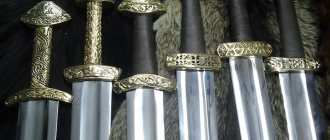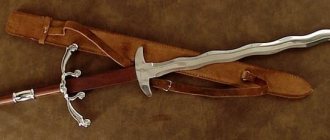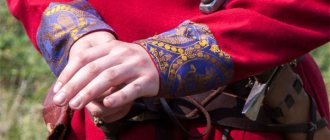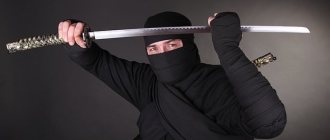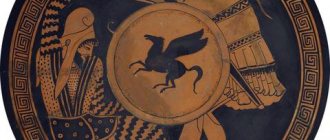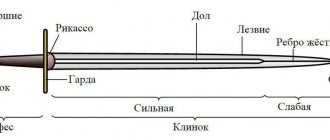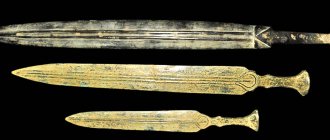The sword has a fairly simple design: a long blade with a hilt, but swords have many shapes and uses. The sword is more convenient than the axe, which is one of its predecessors. The sword is adapted for delivering slashing and piercing blows, as well as for parrying enemy blows. Longer than a dagger and not as easily concealed in clothing, the sword is a noble weapon, a symbol of status, in many cultures. It was of particular significance, being at the same time a work of art, a family jewel, a symbol of war, justice, honor, and, of course, glory.
Sword structure
A sword usually consists of the following elements:
a. Ephesus b. Blade c. Pommel d. Handle e. Guard (crosshair) f. Blade (sharpened part of the blade) g. Point (piercing part)
There are many known variants of blade cross-section shapes. Typically, the shape of the blade depends on the purpose of the weapon, as well as on the desire to combine rigidity and lightness in the blade. The figure shows some double-edged (positions 1, 2) and single-edged (positions 3, 4) variants of blade shapes.
There are three main shapes of sword blades. Each of them has its own advantages:
- The straight blade(s) are intended primarily for thrusting.
- The blade, bent back towards the butt (b), causes a deep cut wound upon impact.
- A blade curved forward toward the edge (c) is effective for slashing, especially when it has a flared and heavy top.
It is important to understand that the specialization of the sword on one type of blow did not make other types impossible - a thrust can be delivered with a saber, and a cutting blow with a sword.
When choosing a sword, civilians were guided mainly by fashion trends. The military tried to find the ideal blade, combining the same effectiveness in both chopping and piercing blows.
Katana Uchigatana
This unique katana is the creation of Oriental gunsmiths. The razor-sharp blade cuts through flesh like butter and causes severe bleeding that can bring down an enemy. The katana strikes vertically, so you can use it in narrow passages. The downside of a katana is its lack of strength and breaks easily.
You can find this item at the beginning of the game in the Firelink Shrine. Take a good look around the area around the Temple. Fight Judge Gundir. There is a gate to the left of the Temple. Go left along the wall. There you will see another gate, it is guarded. Kill the beggar and take the weapon. You will also receive 2000 souls and clothing items.
Africa and Middle East
In most of these regions the sword is a very common weapon, but in Africa it is rare and difficult to date. Most of the swords shown here ended up in Western museums and collectors thanks to travelers in the 19th and early 20th centuries.
Africa
- Double-edged sword, Gabon, West Africa. The thin blade is made of steel, the handle of the sword is wrapped in brass and copper wire.
- Takouba, sword of the Tuareg tribe of the Sahara.
- Flissa, sword of the Kabyle tribe, Morocco. Single-edged blade, decorated with engraving and inlaid with brass.
- Cascara, a straight, double-edged sword of the Bagirmi people, Sahara. The style of this sword is close to Sudanese swords.
- The double-edged sword of the East African Maasai. The blade has a rhombic cross-section; there is no guard.
- Shotel, double-edged sword with a double curved blade, Ethiopia. The crescent shape of the sword is designed to strike an enemy behind his shield.
- Sudanese sword with a characteristic straight, double-edged blade and cross-shaped guard.
- Arab sword, XVIII century. The blade is probably of European origin. The silver hilt of the sword is covered with gold.
- Arabic sword, Longola, Sudan. The double-edged steel blade is decorated with geometric patterns and the image of a crocodile. The hilt of the sword is made of ebony and ivory.
Near East
- Kilic (klych), Türkiye. The example shown in the figure has a 15th-century blade and an 18th-century hilt. Often, at the top, the kilij blade has an elman - an expanded part with a straight blade.
- Scimitar, classic form, Türkiye. A sword with a single-edged blade curved forward. The bone handle has a large pommel and there is no guard.
- Scimitar with a silver handle. The blade is decorated with corals. Türkiye.
- Saif, a curved saber with a distinctive pommel. It is found wherever the Arabs lived.
- Checker, Caucasus. Circassian origin, widely used by Russian cavalry. the blade of this specimen is dated 1819, Persia.
- Dagger, Caucasus. The dagger could reach the size of a short sword; one such example is presented here.
- Shamshir, typical form. Persian saber with a curved blade and a characteristic hilt.
- Shamshir with a wavy blade, Persia. The steel handle is decorated with gold inlay.
- 18. Quaddara. Large dagger. The handle is made of horn. The blade is decorated with etching and gold checkering.
Final Fantasy 7
And here's another one. One of the most famous swords in the series is Cloud Strife's personal weapon. Huge, but doesn't look like it's really out of the realm of possibility. Albeit cumbersome. They seem to have completely forgotten about gravity. This is probably why this sword doesn’t seem heavy to Cloud. What the hell is gravity anyway?
We even received an order for it.
They didn’t take it, since the thing is awkward purely from a weight point of view. It’s just a steel plate, there’s no point in sharpening it - it can be flattened if you’re strong enough to lift it. Technically the sword is real. We take a sheet of steel, forge it, harden it. But it’s better not to make holes, they are very inconveniently located there. Although given the overall width, most likely they won’t have much of an impact. And the sword will break not because of them, but because of the disproportion between the width of the blade, the weight and width of the handle. The shank is too thin. Even the resonance of a strong impact on a hard surface can damage it. Our American colleagues made one from soft alloys. They even chopped something with them. But from combat steel - no, it won’t work. Well, actually, as always, the question is - what is the point of it? If it were three times thinner, it would still have enough weight to cut through or flatten any knight. In general, there are two main problems with weapons in games. The first is the discrepancy between its weight and the real strength of a person. Okay, let's leave it to the superpowers of the heroes. But the main thing is the discrepancy between the weapons and the protective equipment taken by the authors. Let's take any anime or even the fairly good Lord of the Rings by Jackson (I'm talking about the film). Is there a lot of armor there? Yes. Everything is in armor. Big, scary and massive. Does she often save? Do the blows often just clank against the steel? No. Well, a couple of times throughout the film, to add drama to the moment. This is where the semantic content falls apart. If in the Finale there are no opponents who would need to be flattened, and the flesh of monsters is easier to chop with a regular saber, then what is the point of such a weapon?
- Andrey
Indian subcontinent
The region of India and adjacent areas is rich in various types of swords. The best steel blades in the world with luxurious decorations were made in India. In some cases, it is difficult to give the correct name to some samples of blades, to determine the time and place of their manufacture, so a thorough study of them is still ahead. Dates shown apply to examples shown only.
- Chora (Khyber), a heavy single-edged sword of the Afghan and Pashtun tribes. Afghanistan-Pakistan borderland.
- Tulwar (talwar). Sword with a curved blade and a hilt with a disc-shaped pommel, India. This specimen was discovered in Northern India, 17th century.
- Tulwar (talwar) with a wide blade. Was the executioner's weapon. This specimen originates from Northern India, XVIII-XIX centuries.
- Tulwar (talwar).Punjabi style steel handle with safety bail. Indore, India. End of the 18th century
- Khanda, steel handle with gilding in the “Old Indian” style. Double-edged straight blade. Nepal. XVIII century
- Khanda. The handle is made in the style of “Indian basket” with an appendage for gripping with both hands. Marathi people. XVIII century
- Sucker pattah. The handle is made in the Indian basket style. Forward curved reinforced blade with one blade. Central India. XVIII century
- South Indian sword. Steel handle, square wooden pommel. The blade is curved forward. Madras. XVI century
- Sword from the temple of the Nayar people. Brass handle, double-edged steel blade. Thanjavur, South India. XVIII century
- South Indian sword. Steel handle, double-edged wavy blade. Madras. XVIII century
- Pata. An Indian sword with a gauntlet - a steel guard that protected the hand up to the forearm. Decorated with engraving and gilding. Oudh (now Uttar Pradesh). XVIII century
- Adyar katti is of typical shape. A short, heavy blade curved forward. The handle is made of silver. Coorg, South West India.
- Zafar Takeh, India. Attribute of a ruler at audiences. The top of the handle is made in the shape of an armrest.
- Firangi (“stranger”). This name was used by the Indians for European blades with Indian handles. Shown here is a Maratha sword with a 17th century German blade.
- A double-edged two-handed sword with hollow iron pommel. Central India. XVII century
- Bark. The blade is curved forward, has one blade with a “pulled” apex. Nepal. XVIII century
- Kukri. Long narrow blade. It was widespread in the 19th century. Nepal, around 1850
- Kukri. Iron handle, elegant blade. Nepal, approximately 19th century.
- Kukri. Was in service with the Indian Army in World War II. Manufactured by a contractor in North India. 1943
- Ram dao. A sword used for animal sacrifice in Nepal and Northern India.
***
We're done with the swords. But we also talked about Andrey’s work. He is one of the blacksmiths who makes swords and many other weapons, and can be purchased from the Good Claymore online store. Actually, read it. You'll like it.
JoeOwl: In general, the store is very good, so I think the reason I'm writing this article primarily is to let people see that swords are still being made and exist. That these are not the dreams of the Middle Ages, and for a certain price, like in the Middle Ages, they can make you an ordinary sword. Or do you also make unusual ones to order?
Andrey: We do. The site has a section with unique ones, but not everything is there. Among the latest unique works that are not yet on the site, for example, Kirito’s sword from the anime SAO.
JoeOwl: At least it looks simple. This is not a sword for you... but even Ichigo from Bleach, who is the size of a person, although he does not have any guards or curls.
Andrey: Well, it depends on how you look at it. This is perhaps the most elaborate version that we have done. And precisely because they did it because at least it had a more or less adequate basis. Ichigo doesn't have a sword there, but a shovel. From shovels, we only made Guts's sword from Berserk; it is quite large, although in the anime it is the smallest and earliest of his swords.
JoeOwl: But people ordered swords that would not be used for fencing? For all sorts of gatherings, cosplays, no?
Andrey: We usually don’t take on things that have absolutely no connection with reality, this time. Secondly, the same sword from Bleach simply would not have been brought to the meeting. And third, most fantasy swords are very expensive. Very - in the sense of completely. The reason is the large amount of artistic design, for which it is necessary to attract individual masters. For example, casting a wolf's head for Jon Snow's sword cost more than the base sword itself on which the pommel is attached.
Far East
- Tao. Sword of the Kachin tribe, Assam. The example shown shows the most common blade shape of many known in this region.
- Dao (noklang). Two-handed sword, Khasi people, Assam. The hilt of the sword is iron, the trim is made of brass.
- Dha. Single-edged sword, Myanmar. The cylindrical hilt of the sword is covered with white metal. Blade inlay with silver and copper.
- Castanet. The sword has a carved wooden hilt and a steel safety guard. Decorated with silver and brass inlay. Sri Lanka.
- Single-edged Chinese iron sword. The handle is a blade stalk wrapped in cord.
- Talibon. Short sword of Filipino Christians. The hilt of the sword is made of wood and braided with reed.
- Barong. Short sword of the Moro people, Philippines.
- Mandau (parang ihlang). Sword of the Dayak headhunter tribe, Kalimantan.
- Parang pandit (pandat). Sword of the Sea Dayak tribe, Southeast Asia. The sword has a single-edged, forward-curved blade.
- Kampilan. Single-edged sword of the Moro and Sea Dayak tribes. The handle is made of wood and decorated with carvings.
- Klewang. Sword from Sula Vesi Island, Indonesia. The sword has a single-edged blade. The handle is made of wood and decorated with carvings.
Zweihander
This sword can be bought from Greyrat - it is a funny Gray Rat gnome with a cap on his head (the purchase will cost you 6,000 souls). But first, Gray Rat must go on a sortie. You may not need this sword much, since the sword is quite slow in attacks and can be controlled with two hands.
The positive aspect is good damage.
Europe of the Bronze and Early Iron Ages
The history of the European sword is a process not so much of improving the functionality of the blade as of changing it under the influence of fashion trends. Swords made of bronze and iron were replaced by steel ones, the design was adapted to new theories of combat, but no innovations led to a complete abandonment of the old forms.
- Short sword. Central Europe, early Bronze Age. The blade and hilt of the sword are connected with a riveting.
- Curved single-edged short sword, Sweden. 1600-1350 BC. The sword is made from a single piece of bronze.
- Bronze sword from Homeric times, Greece. OK. 1300 BC This specimen was found in Mycenae.
- Long solid bronze sword, one of the Baltic islands. 1200-1000 BC.
- Late Bronze Age sword, Central Europe. 850-650 BC.
- Iron sword, Hallstatt culture, Austria. 650-500 BC. The hilt of the sword is made of ivory and amber.
- Xiphos is the iron sword of the Greek hoplites (heavily armed infantry). Greece. Approximately VI century. BC.
- Falcata - iron single-edged sword, Spain, around V-VI centuries. BC. Swords of this type were also used in classical Greece.
- Iron blade of a sword, La Tène culture. Around the 6th century. BC. This specimen was found in Switzerland.
- An iron sword. Aquileia, Italy. The hilt of the sword is made of bronze. Around the 3rd century. BC.
- Gallic iron sword. Department of Aube, France. Anthropomorphic bronze handle. Around the 2nd century. BC.
- Iron sword, Cumbria, England. The hilt of the sword is made of bronze and decorated with enamel. Around the 1st century.
- Gladius. Iron Roman short sword. Beginning of the 1st century
- Roman gladius of late type. Pompeii. The edges of the blade are parallel, the tip is shortened. End of the 1st century
Europe of the Middle Ages
Throughout the early Middle Ages, the sword was a very valuable weapon, especially in Northern Europe. Many Scandinavian swords have richly decorated hilts, and X-ray studies have revealed the very high quality of their blades. However, the late medieval sword, despite its significant status as a knight's weapon, often has a conventional cruciform shape and a simple iron blade; Only the pommel of the sword gave the craftsmen some scope for imagination.
Early medieval swords were forged with wide blades designed to deliver a slashing blow. From the 13th century Narrow blades, also intended for stabbing, began to spread. It is assumed that this trend was caused by the increased use of armor, which was easier to penetrate with a piercing blow at the joints.
To improve the balance of the sword, a heavy pommel was attached to the end of the handle as a counterweight to the blade. The pommels had a wide variety of shapes, the most common of which are:
- Mushroom
- In the form of a “teapot cover”
- American walnut shape
- Disc-shaped
- Wheel shaped
- Triangular
- Fishtail
- Pear-shaped
Viking sword (right), 10th century. The handle is wrapped in silver foil with an embossed “braided” design, which is shaded with copper and niello. The double-edged steel blade has a wide and shallow fuller. This sword was found in one of the Swedish lakes. Currently kept in the State Historical Museum in Stockholm.
Middle Ages
- Wide iron single-edged sword. Denmark. Found in a swamp. 100-300
- Double-edged iron sword with a bronze hilt and scabbard. Denmark. 400-450
- Single-edged Viking sword. Norway. Around 800
- Caroling is a double-edged iron sword. Scandinavia. 9th or 10th centuries
- German double-edged sword with an American walnut pommel. 1150-1200
- Falchion, England, 1260-1270. A short, heavy sword with a curved blade. The back of the blade can be straight, curved or beveled near the tip. This copy is kept in Durham Cathedral.
- A double-edged sword with a triangular pommel. Around 1380
- Bastard sword (one-and-a-half-handed, or simply one-and-a-half, sword). Around 1380. This type of sword has a long handle, which made it possible to use the sword with both one and two hands, which is why they were also called one-and-a-half-handed.
- Sword from the late 14th century, France. The blade tapering towards the end is intended for stabbing.
- Sword from the late 14th century, Italy. The guard has a bracket for the index finger. This guard made it easier to use the weapon.
- Sword with two finger clips, Spain. End of the 15th century
Renaissance and 17th century
In the XVI-XVII centuries. the sword has undergone certain changes. Two-handed swords became widespread, and later they were also used as ceremonial weapons. One-handed swords have changed much more than they have in the previous few centuries. The guard became more complex as the use of protective armor declined. Rapiers appeared.
Two-handed and one-and-a-half-handed (one and a half) swords
- Bastard sword, Southern Germany, early 16th century. It has a spiral pommel and forward-curved guard shoulders.
- Two-handed sword, Germany. The cross-section of the blade has the shape of a flat diamond. Beginning of the 16th century
- Borschvert (perschvert) - a piercing sword without a blade, Germany. The cross-section of the blade is diamond-shaped. First half of the 16th century
- Claymore (claydhim mor). Two-handed sword, Scotland. Mid-16th century
- Bastard sword, Germany, 1540-1580. The blade of the sword is single-edged, the lower third of the blade is double-edged.
One-handed swords of the 16th-17th centuries
- Cinqueda. Italy. A shortened variety of the cinquedea was used as a dagger. Around 1500
- Katsbalger (“cat knocker”) is a double-edged sword with a horizontal S-shaped guard. Weapons of German mercenaries (landsknechts) of the 16th century.
- Sword of Gustav Vasa, the Swedish king. The sword was made in Germany around 1550. Currently located in the Arsenal, Stockholm.
- Schiavona, a double-edged sword with a protective “basket” on the hilt. Venice. Around 1600
- Sword. Double-edged broadsword, Scotland. Braided guard. Around 1610
- Saber, mid-17th century, Switzerland. Has a characteristic open guard.
Soulcalibur
The sword may be ordinary, but only until the moment it turns into a whip. And it’s good in battle, and it kicks your legs like A’s if someone suddenly decides to run away.
Everything is simple here. This is fiction from a purely constructive point of view. How does it “transform”? Even if we assume that there is a spring, which, under the influence of the absolutely monstrous force of the swing, somehow stretches and then gathers again, it would quickly spread and weaken. This is if you lower the moment with monstrous force. Moreover, the purpose is unclear. What if it is not the cutting edge that hits the target, but, on the contrary, the gap with the rope? What if it gets stuck? What if he gets tangled up in a donut? And lastly, how can they defend themselves? If the design of the sword is movable, then it will not hold a blow.
- Andrey
